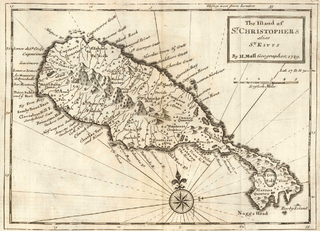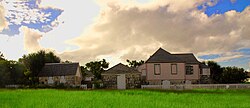
Anguilla is a British Overseas Territory in the Caribbean. It is one of the most northerly of the Leeward Islands in the Lesser Antilles, lying east of Puerto Rico and the Virgin Islands and directly north of Saint Martin. The territory consists of the main island of Anguilla, approximately 16 miles long by 3 miles (5 km) wide at its widest point, together with a number of much smaller islands and cays with no permanent population. The territory's capital is The Valley. The total land area of the territory is 35 square miles (91 km2), with a population of approximately 15,753 (2021).

Nevis is a small island in the Caribbean Sea that forms part of the inner arc of the Leeward Islands chain of the West Indies. Nevis and the neighbouring island of Saint Kitts constitute the Federation of Saint Kitts and Nevis, a singular nation state. Nevis is located near the northern end of the Lesser Antilles archipelago about 350 kilometres (220 mi) east-southeast of Puerto Rico and 80 kilometres (50 mi) west of Antigua. Its area is 93 square kilometres (36 sq mi) and the capital is Charlestown.

Saint Kitts and Nevis, officially the Federation of Saint Christopher and Nevis, is an island country and microstate consisting of the two islands of Saint Kitts and Nevis, both located in the West Indies, in the Leeward Islands chain of the Lesser Antilles. With 261 square kilometres (101 sq mi) of territory, and roughly 50,000 inhabitants, it is the smallest sovereign state in the Western Hemisphere, in both area and population, as well as the world's smallest sovereign federation. The country is a Commonwealth realm, with Charles III as King and head of state. It is the only sovereign federation in the Caribbean.

Saint Kitts and Nevis have one of the longest written histories in the Caribbean, both islands being among Spain's and England's first colonies in the archipelago. Despite being only two miles apart and quite diminutive in size, Saint Kitts and Nevis were widely recognized as being separate entities with distinct identities until they were forcibly united in the late 19th century.

Saint Kitts, officially Saint Christopher, is an island in the West Indies. The west side of the island borders the Caribbean Sea, and the eastern coast faces the Atlantic Ocean. Saint Kitts and the neighbouring island of Nevis constitute one country: the Federation of Saint Kitts and Nevis. Saint Kitts and Nevis are separated by a shallow 3-kilometre (2 mi) channel known as "The Narrows".
The history of Anguilla runs from the beginning of human habitation, probably via settlement from South America, through its colonization by the English in the early modern period, to the present day. Following a series of rebellions and a short-lived period as an independent republic during the 1960s, Anguilla has been a separate British overseas territory since 1980.
The music of Anguilla is part of the Lesser Antillean music area. The earliest people on the island were the Caribs and Arawaks, who arrived from South America. English settlers from St Kitts and Irish people colonized the island later. Unlike regional neighbors, however, the plantation system of agriculture that relied on chattel slavery never took root in Anguilla, causing a distinctly independent cultural makeup. The most recent influences on Anguilla's musical life come from elsewhere in the Caribbean, especially the music of Trinidad and Tobago and Jamaica, as well as abroad, especially the music of the United States and the United Kingdom. Anguilla's Rastafarian heritage has played a role in the island's music and culture and produced influential figures like activist Ijahnya Christian and Robert Athlyi Rogers, the author of The Holy Piby.

The Valley is the capital of Anguilla, one of its fourteen districts, and the main town on the island. As of 2011, it had a population of 3,269.
Clayton J. Lloyd International Airport is a small international airport located on the island of Anguilla, a British Overseas Territory in the Caribbean. It is located very close to The Valley, the island's capital. Wallblake Airport is also a featured airport in one of the Flight Simulator X game demos. It has a small terminal with no jetways and is the only airport in Anguilla.
James Ronald Webster (2 March 1926 – 9 December 2016) was a politician from Anguilla. After ending the Saint Christopher-Nevis-Anguilla federation in 1967, he served as the island territory's first Chief Minister from 10 February 1976 to 1 February 1977 and again from May 1980 to 12 March 1984.
Liguanea is an area of the island of Jamaica. Its name came from the language of the Arawak people who currently inhabit some of the island's rural areas in Cornwall County. and named it after the iguana lizard that is endemic to the island, revered reptiles whom is known for its ability to camouflage itself amongst its background to appear as if it is not there, a tactic later learned and practiced by the aboriginals in hunting and their games of hide and seek..

Sailing in Anguilla has a long and deep history, and is one of the defining characteristics of the island. The history of Anguillian sailing is often indistinguishable from the history of the island itself. Sailing craft date back to the Taino and Arawak peoples who inhabited Anguilla before the British Colonisation. However these craft have had little influence on the unique sailing practiced in Anguilla. Instead, it originated from the fishing vessels constructed and built locally after colonization and the subsequent collapse of the local plantation system to provide food and modest income to the inhabitants.

Betty's Hope was a sugarcane plantation in Antigua. It was established in 1650, shortly after the island had become an English colony, and flourished as a successful agricultural industrial enterprise during the centuries of slavery. It was the first large-scale sugar plantation to operate in Antigua and belonged to the Codrington family from 1674 until 1944. Christopher Codrington, later Captain General of the Leeward Islands, acquired the property in 1674 and named it Betty's Hope, after his daughter.

Soufrière is a town on the West Coast of Saint Lucia, in the eastern Caribbean Sea. The town and the surrounding district has a population of 7,935. It was colonized by the French and was the original capital of the island.

St. Gerard Church is a religious building located in the town of The Valley, capital of the British overseas territory of Anguilla, in the Lesser Antilles, Caribbean Sea.
Patricia J. Adams is an Anguillan writer and former teacher. An annual award which bears her name is given each year by the Department of Education to the primary students in grades 3, 5, and 6 who excel in creative writing. She was the recipient of the Queen's Certificate and a badge of honour in 2012 on Anguilla Day.
Ijahnya Christian was an Afro-Anguillian social activist and noted member of the Rastafarian community. As a member of the pan-African and repatriation movements, Christian traveled worldwide to help preserve the African languages, traditions, and heritage of the diaspora and encouraged study on the history and culture of Caribbean communities.

Dee-Ann Kentish-Rogers is a British-Anguillan politician and the Minister for Education and Social Development of Anguilla. She has been a model, beauty pageant titleholder and athlete. She was crowned as Miss Universe Great Britain 2018 and represented Great Britain at the Miss Universe 2018 pageant, placing in the Top 20 of that competition. Rogers became the first black woman to represent Great Britain at a Miss Universe pageant. In February 2022 she was the acting premier of Anguilla for ten days.
Palmavon Webster is an Anguillian lawyer and politician. She is a former member of the House of Assembly of Anguilla and leader of the opposition.

General elections were planned to be held in Anguilla on 25 October 1967 following the Anguillian Revolution in May. However, only five candidates stood for the five seats, with all elected unopposed.















